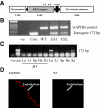Effect of endothelium-specific insulin resistance on endothelial function in vivo
- PMID: 18835939
- PMCID: PMC2584137
- DOI: 10.2337/db07-1111
Effect of endothelium-specific insulin resistance on endothelial function in vivo
Erratum in
- Diabetes. 2009 Feb;58(2):511. Kearney, Mark I [correct to Kearney, Mark T]
Abstract
Objective: Insulin resistance is an independent risk factor for the development of cardiovascular atherosclerosis. A key step in the development of atherosclerosis is endothelial dysfunction, manifest by a reduction in bioactivity of nitric oxide (NO). Insulin resistance is associated with endothelial dysfunction; however, the mechanistic relationship between these abnormalities and the role of impaired endothelial insulin signaling versus global insulin resistance remains unclear.
Research design and methods: To examine the effects of insulin resistance specific to the endothelium, we generated a transgenic mouse with endothelium-targeted overexpression of a dominant-negative mutant human insulin receptor (ESMIRO). This receptor has a mutation (Ala-Thr(1134)) in its tyrosine kinase domain that disrupts insulin signaling. Humans with the Thr(1134) mutation are insulin resistant. We performed metabolic and vascular characterization of this model.
Results: ESMIRO mice had preserved glucose homeostasis and were normotensive. They had significant endothelial dysfunction as evidenced by blunted aortic vasorelaxant responses to acetylcholine (ACh) and calcium ionophore. Furthermore, the vascular action of insulin was lost in ESMIRO mice, and insulin-induced endothelial NO synthase (eNOS) phosphorylation was blunted. Despite this phenotype, ESMIRO mice demonstrate similar levels of eNOS mRNA and protein expression to wild type. ACh-induced relaxation was normalized by the superoxide dismutase mimetic, Mn(III)tetrakis(1-methyl-4-pyridyl) porphyrin pentachloride. Endothelial cells of ESMIRO mice showed increased superoxide generation and increased mRNA expression of the NADPH oxidase isoforms Nox2 and Nox4.
Conclusions: Selective endothelial insulin resistance is sufficient to induce a reduction in NO bioavailability and endothelial dysfunction that is secondary to increased generation of reactive oxygen species. This arises independent of a significant metabolic phenotype.
Figures






Similar articles
-
Accelerated endothelial dysfunction in mild prediabetic insulin resistance: the early role of reactive oxygen species.Am J Physiol Endocrinol Metab. 2007 Nov;293(5):E1311-9. doi: 10.1152/ajpendo.00299.2007. Epub 2007 Aug 21. Am J Physiol Endocrinol Metab. 2007. PMID: 17711985
-
Endothelium-specific insulin resistance leads to accelerated atherosclerosis in areas with disturbed flow patterns: a role for reactive oxygen species.Atherosclerosis. 2013 Sep;230(1):131-9. doi: 10.1016/j.atherosclerosis.2013.06.017. Epub 2013 Jun 29. Atherosclerosis. 2013. PMID: 23958265
-
Divergent effects of genetic and pharmacological inhibition of Nox2 NADPH oxidase on insulin resistance-related vascular damage.Am J Physiol Cell Physiol. 2020 Jul 1;319(1):C64-C74. doi: 10.1152/ajpcell.00389.2019. Epub 2020 May 13. Am J Physiol Cell Physiol. 2020. PMID: 32401607 Free PMC article.
-
Insulin resistance and endothelial cell dysfunction: studies in mammalian models.Exp Physiol. 2008 Jan;93(1):158-63. doi: 10.1113/expphysiol.2007.039172. Epub 2007 Oct 12. Exp Physiol. 2008. PMID: 17933859 Review.
-
Malfunction of vascular control in lifestyle-related diseases: mechanisms underlying endothelial dysfunction in the insulin-resistant state.J Pharmacol Sci. 2004 Dec;96(4):401-5. doi: 10.1254/jphs.fmj04006x4. Epub 2004 Dec 15. J Pharmacol Sci. 2004. PMID: 15599093 Review.
Cited by
-
The Effect of Metabolites on Mitochondrial Functions in the Pathogenesis of Skeletal Muscle Aging.Clin Interv Aging. 2022 Aug 22;17:1275-1295. doi: 10.2147/CIA.S376668. eCollection 2022. Clin Interv Aging. 2022. PMID: 36033236 Free PMC article. Review.
-
Opportunity "nox": a novel approach to preventing endothelial dysfunction in the context of insulin resistance.Diabetes. 2013 Jun;62(6):1818-20. doi: 10.2337/db13-0255. Diabetes. 2013. PMID: 23704524 Free PMC article. No abstract available.
-
Understanding glucose metabolism and insulin action at the blood-brain barrier: Implications for brain health and neurodegenerative diseases.Acta Physiol (Oxf). 2025 Feb;241(2):e14283. doi: 10.1111/apha.14283. Acta Physiol (Oxf). 2025. PMID: 39822067 Free PMC article. Review.
-
FoxOs integrate pleiotropic actions of insulin in vascular endothelium to protect mice from atherosclerosis.Cell Metab. 2012 Mar 7;15(3):372-81. doi: 10.1016/j.cmet.2012.01.018. Cell Metab. 2012. PMID: 22405072 Free PMC article.
-
Inflammation-linked adaptations in dermal microvascular reactivity accompany the development of obesity and type 2 diabetes.Int J Obes (Lond). 2019 Mar;43(3):556-566. doi: 10.1038/s41366-018-0148-4. Epub 2018 Jul 13. Int J Obes (Lond). 2019. PMID: 30006585 Free PMC article.
References
-
- James PT, Rigby N, Leach R: The obesity epidemic, metabolic syndrome and future prevention strategies. Eur J Cardiovasc Prev Rehabil 11 :3 –8,2004 - PubMed
-
- Reaven GM: Banting Lecture 1988: Role of insulin resistance in human disease. Diabetes 37 :1595 –1607,1988 - PubMed
-
- Hanley AJ, Williams K, Stern MP, Haffner SM: Homeostasis model assessment of insulin resistance in relation to the incidence of cardiovascular disease: the San Antonio Heart Study. Diabetes Care 25 :1177 –1184,2002 - PubMed
-
- Haffner SM, D’Agostino R Jr, Mykkanen L, Tracy R, Howard B, Rewers M, Selby J, Savage PJ, Saad MF: Insulin sensitivity in subjects with type 2 diabetes. Relationship to cardiovascular risk factors: the Insulin Resistance Atherosclerosis Study. Diabetes Care 22 :562 –568,1999 - PubMed
-
- Sinaiko AR, Steinberger J, Moran A, Prineas RJ, Vessby B, Basu S, Tracy R, Jacobs DR Jr: Relation of body mass index and insulin resistance to cardiovascular risk factors, inflammatory factors, and oxidative stress during adolescence. Circulation 111 :1985 –1991,2005 - PubMed
Publication types
MeSH terms
Substances
Grants and funding
LinkOut - more resources
Full Text Sources
Other Literature Sources
Molecular Biology Databases
Miscellaneous

